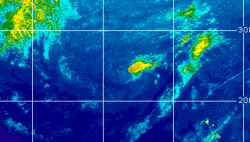Ed Dunham
Former Meteorologist & CFHC Forum Moderator (Ed Passed Away on May 14, 2017)
Reged:
Posts: 2565
Loc: Melbourne, FL
|
 Re: Initial Outlook for the 2011 Atlantic Season
Re: Initial Outlook for the 2011 Atlantic Season
Thu Dec 09 2010 10:25 PM
|
|
|
On Dec 6th, TSR issued its seasonal forecast for 2011: 16/8/4, and on Dec 8th CSU called for 17/9/5. Both lower than their forecast for 2010, but both still quiet high, i.e., they expect a very active Atlantic tropical cyclone season. One comment in the CSU forecast is rather significant: “At this point, we are uncertain whether La Niña conditions or neutral conditions are more likely for the 2011 hurricane season.†The latest (Dec 5th) NCEP ENSO outlook predicts that a moderate La Nina will persist through the 2011 Summer. There is a good chance that the current La Nina will persist through the entire 2011 year with the potential for a multi-year event extending into 2012 – and this is important from a climatological and seasonal forecasting standpoint.
First, some comments from a couple of 2007 posts (that have been updated to include recent seasons of high storm totals):
“About a month ago I did a little research from a slightly different angle. Since ENSO conditions are only available from 1950, I decided to check El Nino Region 3.4 anomalies against all of the very active seasons since 1950. I defined an active season as 14 named storms or more (there have been 13 of these) and ENSO neutral conditions as anything from +0.5C to -0.5C. I used the average sea surface temperature anomaly for the three month period of May, June and July (figuring that a three month lag was reasonable between Pacific ENSO conditions and Atlantic activity). The results coincide nicely with the findings of Ostro & Lyons.
1953...14 storms...+0.4 anomaly
1969...17 storms...+0.4 anomaly
1990...14 storms...+0.3 anomaly
1995...19 storms...+0.1 anomaly
1998...14 storms...+0.1 anomaly
2000...14 storms...-0.5 anomaly (weakening La Nina)*
2001...15 storms...+0.1 anomaly
2003...15 storms.....0.0 anomaly
2004...15 storms...+0.4 anomaly
2005...28 storms...+0.3 anomaly
2007...15 storms...-0.1 anomaly
2008...16 storms...-0.4 anomaly
2010...19 storms...-0.2 anomaly
*Note that since the original 2007 post, the 2000 MJJ SST anomaly has been adjusted by NCEP to -0.5 vice -0.6 .
Conclusion: Although the dataset is limited, it suggests that very active seasons occur under initially 'neutral' ENSO conditions. A strong La Nina doesn't really enhance activity, but a strong El Nino (1992, 1997, 2006) will limit activity. When the M/J/J average SST anomaly is +0.6 or greater, 92% of the time the season storm total will be 8 named storms or less. When that average is -0.6 or greater, 100% of the time the season storm total will be 13 named storms or less (and 83% of the time the season storm total will be 9 to 13 named storms, i.e., a slightly below normal to slightly above normal season. Note that a normal season, because of the increased activity since 1995, is now 11 named storms). A strong pre-season La Nina (anomaly of -1.2 or colder) has never resulted in a high activity storm season. Since 1950, all 13 previous high activity seasons have occurred under ENSO neutral pre-season conditions.â€
Since 1950 there have been 12 seasons with a MJJ SST anomaly of -0.6 (or colder). Those 12 seasons (with storm totals and MJJ ENSO 3.4 anomalies) are as follows:
1950 13/11/8 -1.1
1954 11/8/2 -0.7
1955 12/9/6 -1.0
1956 8/4/2 -0.6
1964 12/6/6 -0.8
1971 13/6/1 -0.8
1973 8/4/1 -0.9
1974 11/4/2 -0.8
1975 9/6/3 -1.1
1985 11/7/3 -0.6
1988 12/5/3 -1.2
1999 12/8/5 -0.8
All of the above helps to illustrate why the CSU comment is significant. If the 2011 MJJ SST anomaly drops to a neutral ENSO state (-0.5 up to +0.5) then a high activity season is possible, but if its -0.6 (or colder) then a high activity season is not likely. At the moment I’m inclined to believe that 13 named storms is a realistic total for 2011 – but that’s just my viewpoint on next season.
Cheers,
ED
|
|



 Flat
Flat



